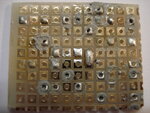neazoi
Advanced Member level 6

- Joined
- Jan 5, 2008
- Messages
- 4,157
- Helped
- 13
- Reputation
- 26
- Reaction score
- 15
- Trophy points
- 1,318
- Location
- Greece
- Activity points
- 37,198
Hi, I have tried for first time to solder smd components using a proffessional hot air rework station and solder paste.
I have tried different air speeds and temperatures and different air approaching distances and the results are very dissapointing.
The solder paste is lead-free but it does not seem to joint together easily into a big solder bubble.
Look at the picture (2mb size).
What could the problem be?
I have tried different air speeds and temperatures and different air approaching distances and the results are very dissapointing.
The solder paste is lead-free but it does not seem to joint together easily into a big solder bubble.
Look at the picture (2mb size).
What could the problem be?






